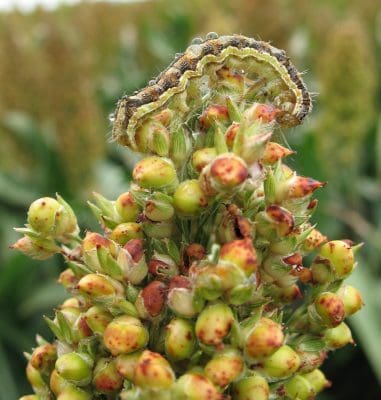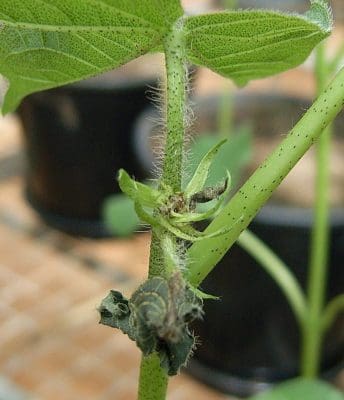INSECTICIDE supplies are running short as waves of heliothis and mirids chew through early-season summer crops in the northern farming regions.

Heliothis in huge numbers – sometimes as many as 10 per head – are attacking early sorghum in the northern farming zone. Photo: The Beatsheet.
The explosion in insect numbers throughout southern Queensland and north-west NSW follows on from a big winter crop and weather conditions that have favoured the pests’ spread.
On Queensland’s Darling Downs, Dalby Rural Supplies head agronomist, Andrew Johnston, said there had been heavy infestations of heliothis in flowering sorghum crops and widespread outbreaks of mirids in cotton.
“There is big insect pressure which has come off the back of the winter crop where a lot of the heliothis have pupated and they are coming back to bite us now. We are getting big numbers – anywhere from four to 10 per head of sorghum, depending on who got the rain and who didn’t,” he said.
“In cotton, mirids have been very heavy. There have been up to two sprays on most of the cotton so far.”
Mr Johnston said the high, early-season demand for sprays to control the outbreaks had seen insecticide supplies run low.
“It seems that every year now we have issues with supply. I don’t know whether the companies aren’t prepared to bring in huge quantities. They just bring in enough to sell out and cover their budgets. We need to be doing a lot more work on forecasting,” he said.
It is a similar story in the summer cropping areas of northern NSW where B&W Rural consulting agronomist, Rob Long, said high insect pressure early in the season meant insecticide product was now in short supply.
“There is unprecedented mirid pressure on cotton. It means spraying early. One cotton consultant said there could be three mirid sprays between here and Christmas if the current pressure keeps up because now is the time the cotton plants are starting to square and you have to spray, otherwise you keep losing fruit,” he said.
Mr Long said the area planted to summer crop in northern NSW was down on last year, largely due to the popularity of winter chickpeas which ate into a lot of the potential summer cropping area.
He said there was a three-way split between sorghum, cotton and mungbeans this year.
“There is an increased mungbean area and a much-reduced sorghum area, which is price driven. It is the lowest sorghum plant we have seen for 15 years,” he said.
“The dryland cotton area would be two or three times what was in last year, albeit off a fairly low base. The introduction of Bollgard 3 has rejuvenated the enthusiasm and opened up the opportunity to plant dryland cotton. The changes to the requirements (which have seen growing restrictions eased for Bollgard 3) have resonated with growers and been part of cotton’s increased popularity this year.
“The mungbean area is up, driven by the relative price of sorghum and people who didn’t have the moisture profiles to plant to cotton and didn’t want to put sorghum in, so their option was mungbeans.”
Mr Long said growing conditions had been ideal and overall the summer crops were progressing well.
“Everything is running three weeks later than normal because of the really wet September/October and the cool temperatures. Most plantings were three weeks late. But that is of no great consequence. It looks terrific.”
On the Downs, Mr Johnston said it had been “a mixed bag” with some producers not able to plant all the summer crop they had planned because of a lack of moisture for dryland sowing.
“There is not as big a plant as we thought because the start of the planting season was cool and we got some unseasonal spring weather which was fantastic for late-planted chickpeas, but not ideal for early-planted spring cotton and sorghum crops,” he said.
“The few early mungbeans that went in have really struggled due to the cold, dry weather, and then a heatwave.
“There hasn’t been anywhere near the amount of sorghum go in this season because of the low commodity prices. The sorghum area is down by about 50 per cent, but the cotton area is up 30 to 40pc on last season across the Downs.”
Mr Johnston said there was plenty of time for more summer crop to be sown, particularly mungbeans, if there was more rain.
“The eastern Downs has got under some good storms in the last 10 days and some people are putting in some summer mungbeans. That will be the big crop of choice that will go in if there is more rain between now and the end of January,” he said.
“There will still be some late sorghum and could be a spike in some late corn.”
Photos: The Beatsheet, http://thebeatsheet.com.au/





PCT International Pty Ltd have sufficient Technical Active to make 5000litres of Vista 200SC & are currently making 1000litres per week of finished product. It is available to any reseller.